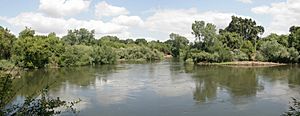Estanislao facts for kids
Quick facts for kids
Estanislao
|
|
|---|---|
| Born |
Cucunuchi
c. 1798 |
| Died | July 31, 1838 (aged 40) |
Estanislao (born Cucunuchi, around 1798 – 1838) was an important Native American leader. He was a member of the Lakisamni tribe, part of the larger Yokuts people in northern California. Estanislao was known for leading groups of Native Americans. They stood up against the Mexican government and the Mission system.
Contents
Estanislao's Early Life
Estanislao was born around 1798. His birthplace was near the Río de Laquisimes. This river is now called the Stanislaus River in Modesto, California.
In 1821, leaders from Mission San José visited his area. They asked Cucunuchi, his wife, daughter, and mother to come to the mission. There, they would receive a Christian education. His younger brother, Orencio, had already visited the mission in 1820.
Cucunuchi and his family arrived at the mission on September 24, 1821. His father did not join them. Soon after, Cucunuchi was baptized. He received the name "Estanislao," which is Spanish for Stanislaus.
Life at the Mission and Leadership
Estanislao became an alcalde at the mission. An alcalde was like a mayor or leader in the community. In 1827, Estanislao left the mission. About 400 followers went with him.
Juan Bojorques wrote about Estanislao in 1887. He described Estanislao as tall and strong. He said Estanislao was "about six feet tall, his skin was more white than bronze, he was very muscular like a horse." Juan Bautista Alvarado also noted that Estanislao could read and write. He was a standout leader among other Native American tribes in Central California.
Leading the Resistance
Estanislao's group began to raid nearby missions. These included Mission San José, Santa Clara, and Mission Santa Cruz. They also raided Mexican settlements. These actions took place around the Laquisimas River. This river is now known as the Stanislaus River.
Other Native American groups joined Estanislao. These included Chumash Indians led by Pacomio and other Yokuts people. At one point, his group grew to about 4,000 men.
Estanislao taught his men battle skills. He had learned these from Spanish and Mexican soldiers. They used techniques like digging trenches and building palisades (strong fences). They also used an early form of guerrilla warfare. This means using surprise attacks and quick retreats. These methods helped them succeed in early battles.
His raids were often sudden and involved traps. They usually ended without loss of life. Sometimes, he would carve his initial, "S," with his sword. This showed his group was responsible. Because of this, some people believe Estanislao was one of the inspirations for the fictional character Zorro.
Battles and Forgiveness
The Franciscan friars and Mexican settlers asked the Mexican army for help. Governor Echeandía sent the army. Three expeditions from the Presidio of San Francisco and the Presidio of Monterey failed to stop Estanislao.
A fourth, larger force was led by General Mariano Guadalupe Vallejo. In the spring of 1829, they finally pushed Estanislao and his people from the Laquisimas River area. After the battle, six Native Americans were captured. Four of them were executed.
Estanislao returned to Mission San Jose on May 31, 1829. He asked Father Narciso Duran for forgiveness for himself and his men. Father Duran successfully asked Governor José María de Echeandía to pardon Estanislao. The pardon was granted on October 7, 1829.
Later Resistance and Challenges
After the pardon, Estanislao returned to the Laquisimas River. He continued to lead his people. In 1831, Yoscolo, a Yokuts Indian from Mission Santa Clara, joined Estanislao's group. Yoscolo brought several hundred Native Americans with him. Yoscolo and Estanislao led many raids against Mexican settlers. Yoscolo sometimes wore a mask during his raids, another link to the Zorro legend.
In the spring of 1833, a serious illness spread. Malaria was brought into the San Joaquin Valley by Canadian beaver trappers. More than 20,000 California natives died from malaria that spring. This included many Yokuts, Chumash, and Miwok people.
Estanislao's Final Years
On August 24, 1834, Estanislao returned to Mission San Jose. He lived there and helped others. He taught them about the Yokuts language and culture. He stayed at the Mission until he died on July 31, 1838. He may have died from smallpox.
The Stanislaus River, Stanislaus County, and the town of Ripon (once called Stanislaus City) are all named in his honor.


